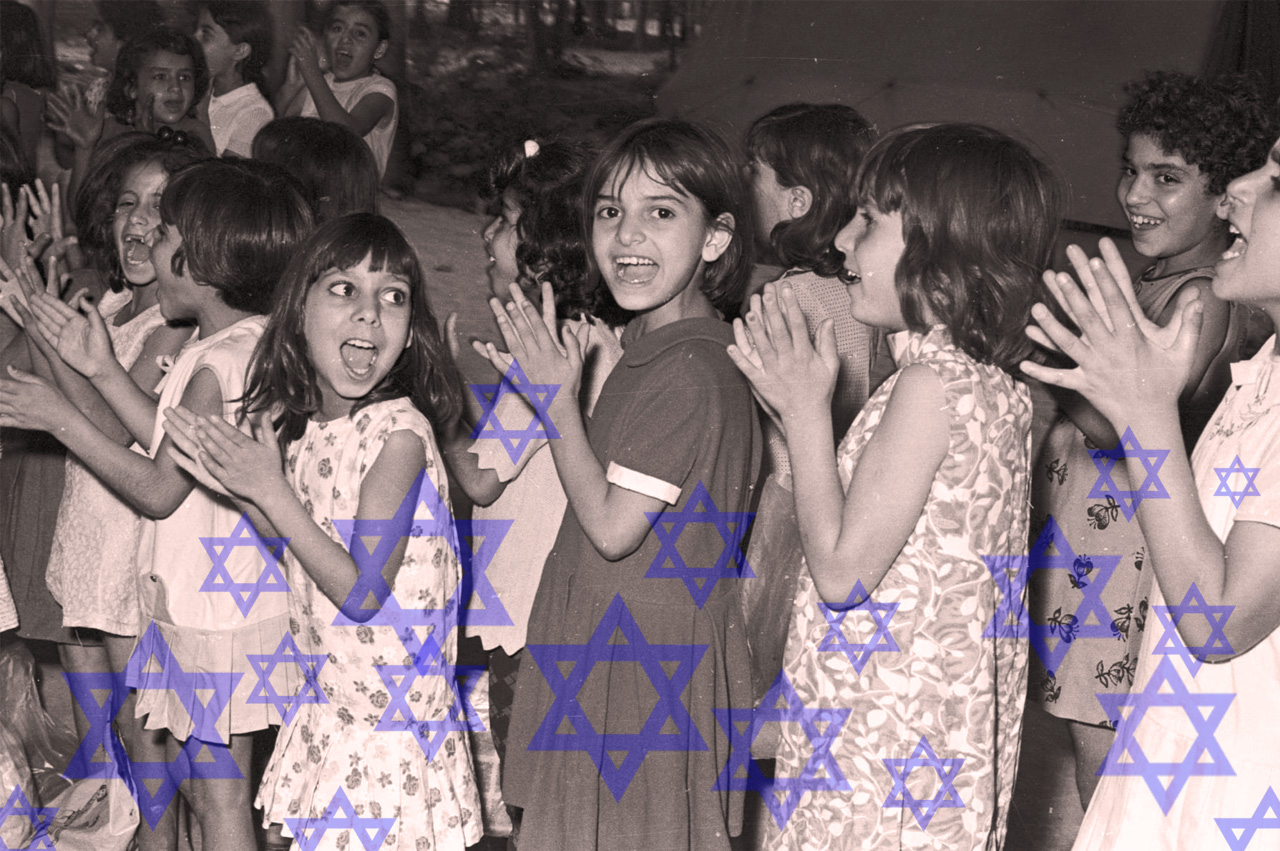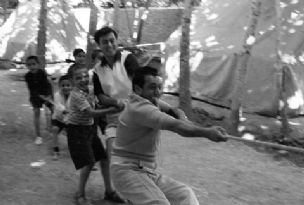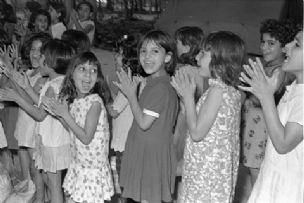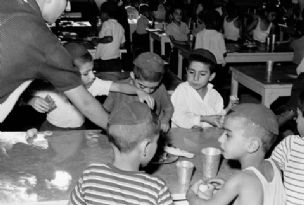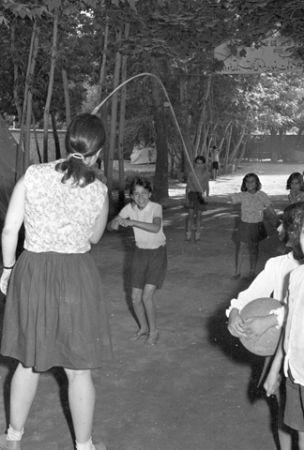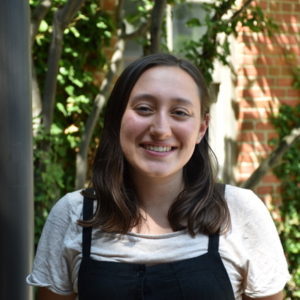In the featured image, Jewish campers sing and dance at one of the JDC’s “children’s colonies”, a Jewish summer camp in Shiraz, Iran. Photograph from the JDC Archives.
“Store in cool, dry place”
Each morning, from mid-June to late August in the 1960s, hundreds of Jewish children traveled on buses to a recreational summer camp outside Shiraz, Iran. Upon arrival, the campers sang the Iranian national anthem and Hatikavah. Throughout the day they played volleyball and ping pong, snacked on hard boiled eggs, tea, and fruit, and sang around campfires. Photos from the summer camp depict children laughing, singing, dancing, and playing.
Caption: Over 20,000 children from across the country attended JDC summer camps in Europe, North Africa, and the Middle East, which provided humanitarian aid in the 1950s and 60s. (Photo courtesy of the JDC Archives.)
Some children ran around in camp-issue shorts. Their clothing read “Store in cool, dry place,” “Government property,” “Hooks prohibited,” and “After opening keep unused flour in tightly covered containers.” Lacking money for proper uniforms, the camp supplemented with donated United States Department of Agriculture (USDA) flour sacks, which were also used for curtains around bathrooms and as handkerchiefs. This bizarre outfit tells how this summer camp in Shiraz did not only exist as a form of countryside recreation for Jewish Iranian city kids, but also operated as a form of humanitarian aid.
Today, when most people think of Jewish summer camp, they likely imagine an experience catering primarily to middle- and upper-class American Jews, who pay thousands of dollars for their children to have an immersive cultural experience for the summer. However, the archives of the Joint Distribution Committee (JDC), a global Jewish humanitarian aid organization, tell a different type of Jewish summer camp story They reveal a little-known history of Jewish summer camps that circles the globe, and with it a legacy of humanitarianism, education politics, and ethnocentrism.
The approximately six hundred children who attended summer camp in Shiraz the summer of 1961 were part of over 20,000 Jewish children from Europe, North Africa, and the Middle East participating in day camps and sleepaway camps run by the JDC, which sought to support Jewish communities in need across the world. Since its founding in 1914, the organization has and continues to provide services such as medical assistance, social work, education, and emigration programs to Jews across the world.
While American Jewish campers during this time were learning Yiddish or singing Zionist songs in attempts to mirror “authentic” European Jews from previous decades, European Jewish children during that time – and many from the Middle East and North Africa – were attending Jewish summer camps for an opportunity to spend time outside of the city, receiving both a vacation and healthcare at once. For some communities, these summer camps even served as a space of physical protection during periods of national conflict or antisemitism.
In a world where some Jewish communities were beginning to find their footing after World War Two while others faced rising tensions, and at a time when the still-new and conflict-ridden State of Israel played an ever-present role on political stages, summer camps created and recreated microcosms of Jewish life across the diaspora. While for a few weeks each summer these summer camps operated as their own worlds, they were also punctured by the outside world – by progressive education, Zionism, and USDA flour sacks.
Caption: The JDC shipped a fifty-five-page handbook across the globe with details on how to work with children, what activities to do, and how to run summer camp. (Photo courtesy of the JDC Archives.)
“Since children are going to be influenced by their environment in any case, we might just as well see that the influence is in the right direction.”
“Give them full approval for everything they do well, without exaggeration.” “Make the Sabbath a rich and inspiring event at the colony.” “Remember that no one expects you to be ‘born’ a counselor, but you are expected to ‘become’ one.”
At summer camp, or as some European countries called them, children’s colonies, these are only a few of the many instructions for counselors laid out by the JDC over the course of fifty-five pages in the JDC Special Consultant for Jewish Summer Camps Deborah Miller’s “Handbook for Counselors of Jewish summer colonies and camps.” The JDC translated the Handbook into many languages including Greek, Serbo-Croatian, German, Swedish, and French, and shipped across the globe. The book not only contained detailed instructions for how to run a summer camp, but also implicit directions for enforcing an outsider approach to childcare on local communities, regardless of the cost.
Miller specifically intended for the Handbook to influence local Jewish life. In the same year she published the Handbook, she wrote in a report on summer camps, “Since children are going to be influenced by their environment in any case, we might just as well see that the influence is in the right direction.” This meant forcing a Western approach to childcare and education on Jewish communities around the world. If children attended a JDC summer camp that closely followed the Handbook, they would have received a trophy for good sportsmanship, even if they lost that summer’s relay races or volleyball tournament. Their counselors would have been careful never to raise their voices at their campers, instead asking them their opinion on the day’s programming.
This approach to education reflected debates occurring during the postwar period in the United States, in which educators debated between a stricter, more traditional approach to teaching, versus a progressive approach that focused on innovation and freedom. The latter ideology drew on the theory of psychologist and education reformer John Dewey, considered the founder of progressive education, who emphasized play and the potential for education to turn pupils into upstanding citizens.
Yet, entering communities from the outside, the JDC brought a colonial mindset towards enforcing its approach towards child education, often conflicting with local culture. According to Donna Garson, the JDC staff member who started the summer camp in Shiraz, in a report to the organization, those at summer camp “saw children behaving normally and responding to discipline when put in normal conditions in small groups (15) for the first time in their lives.” Regardless of what one actually viewed as “normal,” Garson wielded a lot of power in Shiraz, and descriptions of her interactions with the local community depict a hierarchy placing her on top as the Western outsider. One JDC report from a few years later calls her the Queen of Shiraz. “Her ‘subjects’ are the 11,5000 Jews who live in Shiraz and Isfahan,” the report writes. “Not much escapes Miss Garson’s sharp eyes. Are the women in the kitchen at the day care center cooling off the hard-boiled eggs properly before serving them to the children? Miss Garson comes along and pokes a finger into the pan where they are cooling to test the temperature of the water […] In her nine years in Shiraz, Miss Garson has been one of the prime movers of the revolution JDC has helped to bring about in the lives of Iran’s 80,000 Jews.”
Garson’s approach extended to gender dynamics in leadership as well. In Shiraz, Garson wrote, “The girl counsellors, because of their position in Iran even within the family, found it difficult at first to give directions and assume authority. The first day they had to eat with the children, some burst into tears feeling dishonored!!” She later writes, “Iran is certainly not a woman’s world ….yet.”
While Garson saw the summer camp as a success, calling it “a demonstration of what could and should be done for children from rock bottom living quarters,” she did not understand why local leaders expressed “no terrific enthusiasm” towards the project. The JDC’s report on the “Queen of Shiraz” and Garson herself praise the organization’s work in Iran, but an ethnography on Shiraz in the 1960s tells of local hatred towards the JDC that Garson’s eurocentric mindset could not see.
“Resentment towards Joint derives from the many years of foreign administration of the Shiraz operation,” ethnographer Laurence Loeb wrote. “The director during the period of research, a female social worker, was persevering in her efforts to effect positive social change, but her methods were ethnocentric and thus often inappropriate to the particular circumstances. She also chose not to speak Persian, necessitating the use of interpreters at every formal and informal encounter. This tactic not only handicapped the flow of communication, but engendered considerable hostility from all segments of the community who considered her aloof and unsympathetic. Furthermore, the elite especially resented any female, even a westerner, trying to impose her will on the leadership.”
Loeb spells out a problem not unique to the JDC, but an issue present in humanitarianism more broadly, complicating the image of grinning children at summer camp with local tensions: “In sum, Shirazi Jewish hostility to Joint expresses the common resentment of the socially distant, lofty, paternalistic foreigner.”
Caption: Summer camps created Jewish community in different ways, with Zionist, nationalist, socialist, traditional, secular, and other types of camps. (Photo courtesy of the JDC Archives.)
“Healthy young Jewish citizens”
At summer camps that followed the Handbook, each day began with flag-raising. Campers prayed before and after meals, sang Am Yisrael Hai and David Hameleh, and danced Mayim in a circle. Some children may have fasted or shed tears during the summer’s Tisha B’Ab memorial ceremony.
Today, how summer camps should approach Jewish life is again up for debate. What should camps teach about Israel? Should they engage in activism more broadly? How? In completely different historical moments, these issues have remained; Jewish summer camps in the 1960s grappled with similar questions about Jewish affiliation, both seeking to strengthen Jewish community and identity.
The Handbook instructs counselors, “You share with the directors of this colony the responsibility for seeing that the children have a wonderful summer vacation while they learn and develop as healthy young Jewish citizens.” Yet what did “healthy young Jewish citizens” look like? What sort of religious Jewishness should be practiced? Should a camp affiliate with Zionism? What about its political affiliation? How much freedom did communities have to make these decisions?
In the United States in the 1960s, many summer camps created Jewish life by aligning themselves with a particular Jewish religious or political ideology. Some camps were run by Orthodox, Conservative, or Reform religious movements, and adopted a particular form of prayer, kashrut laws, and gender norms. Other camps identified with a political ideology; Zionist camps raised the Israeli flag, Yiddish camps performed Yiddish plays, and both created their own forms of socialist life. At all these camps, everything from whether to call camp buildings by their names in Hebrew, Yiddish, or English, to whether or not to separate boys and girls during prayer, was a deliberate and often debated decision with religious and political implications.
We see none of these strict affiliations in the Handbook. There are no instructions for whether or not to have a mechitza separating boys and girls during services and no restrictions on food according to kashrut laws. Some guidance does exist; the Handbook includes a few abridged prayers for before and after meals, suggests some Hebrew songs for Shabbat, gives instructions for fasting on Tisha B’Ab, and suggests arts and crafts and theater activities based on Biblical stories. But there is no complete model for Jewish religious practice at summer camp.
Politically, the Handbook provides a confusing mix of ideologies. On the one hand, much of the book includes clearly Zionist programming, with a list of Hebrew vocabulary, lyrics for Hatikva, and other Zionist songs such as Mi Yivneh Hagalil?, or “Who will build the Galilee?” The book includes instructions for events such as an “Israeli Fair” and “Herzl-Bialik anniversary,” celebrating two famous Zionist figures, and encourages art projects with Israeli flags, maps of Israel, and “Trees for Keren Kayemeth l’Israel,” an organization that bought and developed land in Palestine and later Israel.
However, even if the Handbook appears largely Zionist, other activities support camp expressions of local nationalism, such as the suggestion that summer camps in France celebrate Bastille Day. An instruction that counselors sing “many songs, of all kinds […] modern Hebrew, Yiddish and traditional melodies,” alludes to Zionism, Yiddishism, and traditional religious interpretations of Jewishness, all in one sentence. Yet the Handbook lacks folk songs specific to communities that spoke Arabic or other languages that may have better reflected local Jewish culture.
The lack of a single religious model or political ideology in the Handbook provided JDC-funded summer camps with the space to follow their own traditions and politics. One report on summer camps in Europe during the summer of 1961 describes kosher camps, non-kosher camps, a camp run by a Bundist group and another by socialist Zionists. Meanwhile, according to Garson’s report on Shiraz, the camp mixed Zionism and Iranian nationalism, singing both the Iranian and Israeli national anthems and songs.
Yet, it is unclear whether this was the case for all summer camps. In Shiraz for example, one outsider had complete control over life at camp. As the ethnography on Jewish life shows, including Iranian songs in summer camp programming was not enough to erase the resentment towards ethnocentric treatment by the JDC.
Caption: Counselors were warned about “antics” by the children like pillow fights and other mischief. (Photo courtesy of the JDC Archives.)
“Watch for last-night ‘antics’”
Towards the end of the summer, camp counselors helped the children separate clean and dirty clothes, dry their bathing suits, search for lost belongings, and pack their bags. Perhaps some campers stayed up late on the last night, unable to sleep, trying to savor last moments with friends. Maybe counselors caught some children sneaking outside or participating in a pillow fight.
But the JDC documents only tell half the story. The archives don’t have personal narratives from the counselors and directors and children themselves. They lack first-person accounts of how children felt arriving at camp, how locals viewed the JDC, and how campers related to their Jewish identity in a new world outside their home.
In a study of American Jewish summer camps, historian Sandra Fox cites an American Jewish camp director who wrote in the 1960s, “Anyone acquainted with camp life knows that there is a camper sub-culture which exists independently, sometimes in spite of and sometimes for spite, of the official camp programs and policies.”
While as adults, Miller and Garson could not truly know, the two administrators speculate about this “camper sub-culture.” When instructing counselors on the departure of children at the end of the summer, the Handbook warns, “Watch for last-night ‘antics’, such as pillow fights and other behavior manifestations.”
Meanwhile, some of the girls attending the summer camp in Shiraz caused confusion on the first day of camp. The JDC sent families cards with their child’s assigned date for arrival at camp, however, Garson writes of how “the girls swopped or sold cards and this created chaos the first days of each period.” These details give clues to the rest of the story, to what ends up left to the memories of former campers and our own speculation: the personal interactions between friends, the games played when the lights went out, and everything else that happened when the adults weren’t looking.
Yet, the JDC’s archives do still manage to tell a lot about life at summer camp, particularly its ethnocentric approach to local communities and childcare in the postwar era. They tell how a progressive framework towards education dominated the JDC’s work with children during this period, even if this approach sometimes clashed with local culture. Zionism is reflected in many of the JDC’s suggestions for creating Jewish life in summer camps, yet the organization also leaves space for local groups to make Jewish life their own. Meanwhile, the archives show brief snapshots of the children themselves, smiling for the camera, eating dinner in a mess hall, jumping rope in a camp yard.
These snapshots open a window into humanitarian aid Jewish summer camps, communities that only existed for a few weeks each year. They tell about the world of the JDC, and about how some staff brought an ethnocentric mindset and sought to force change, regardless of the adverse reaction of local community members. They show different versions of Jewishness across Europe and the Middle East, while suggesting the growing presence of Zionism. Most of all, these archives lay bare the inherent problems with well-intended humanitarianism, of what happens when an outsider comes into a community without listening to community leaders and rooting themselves in local culture. ⋄
